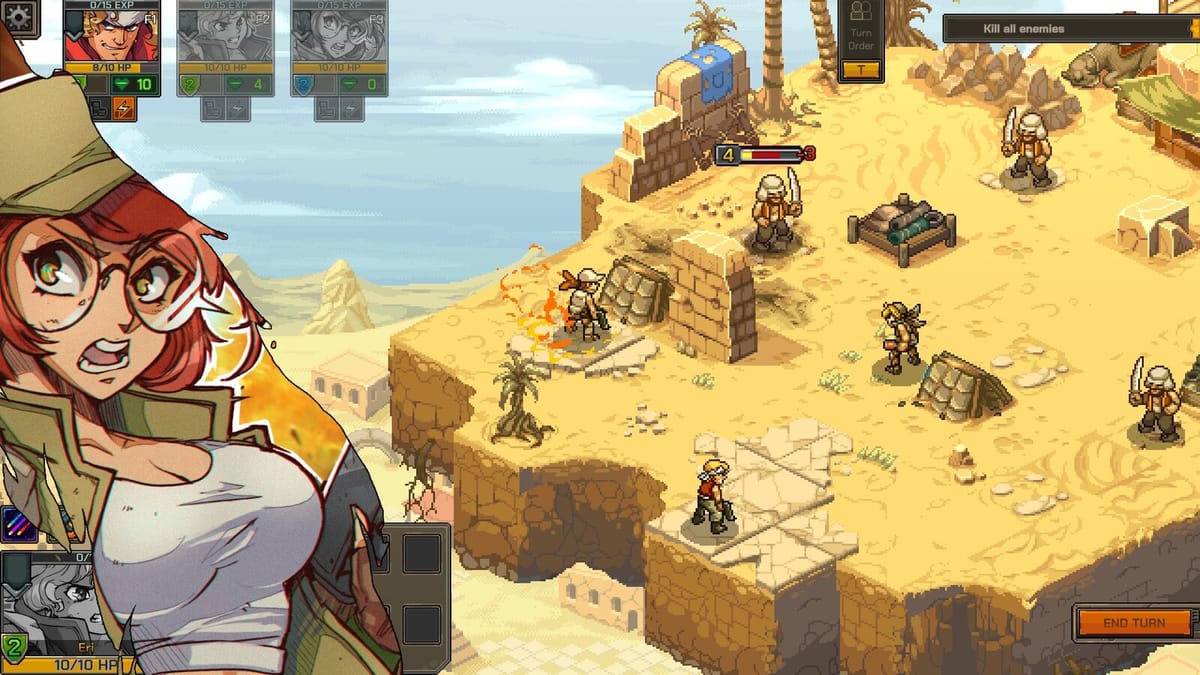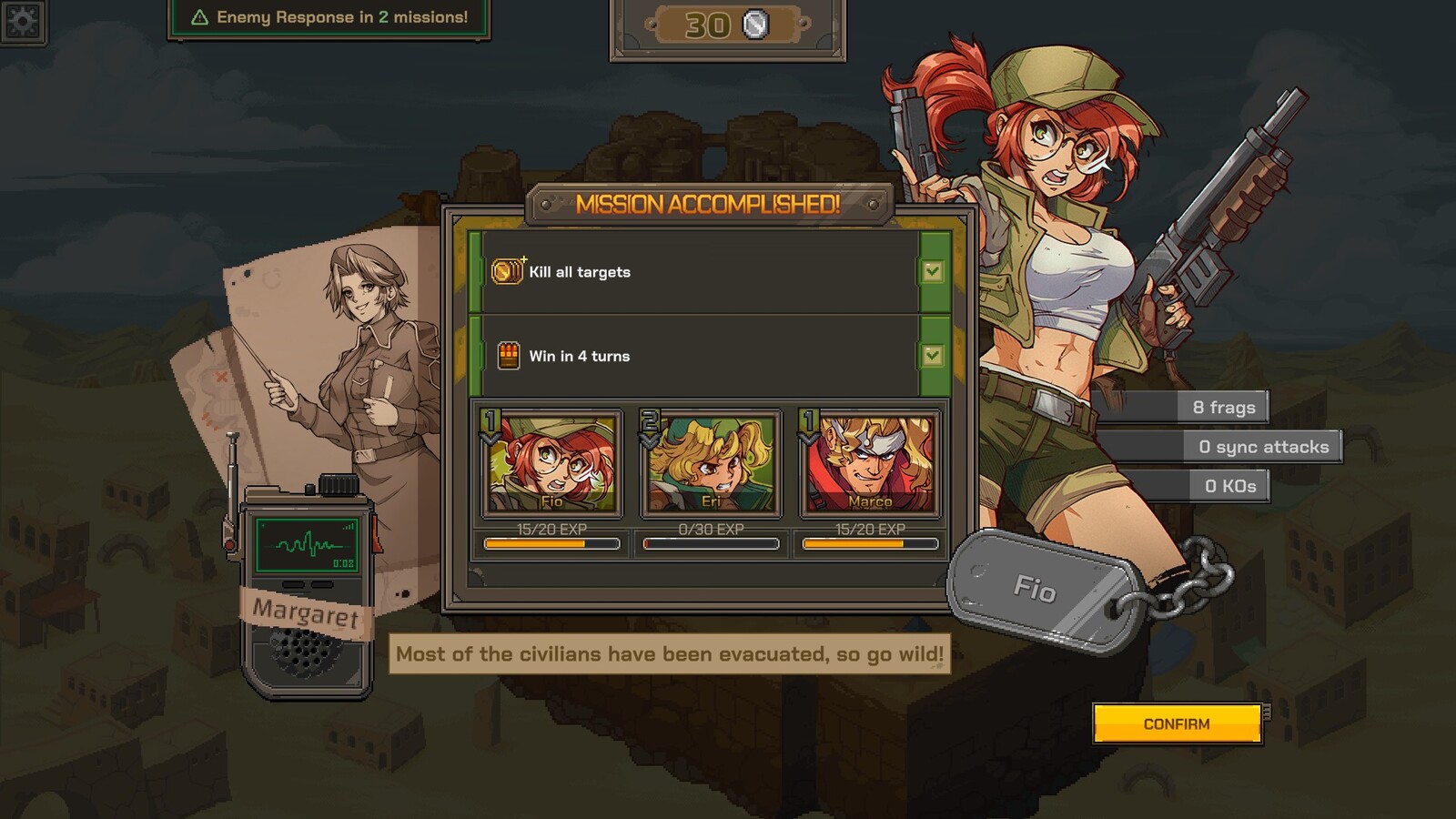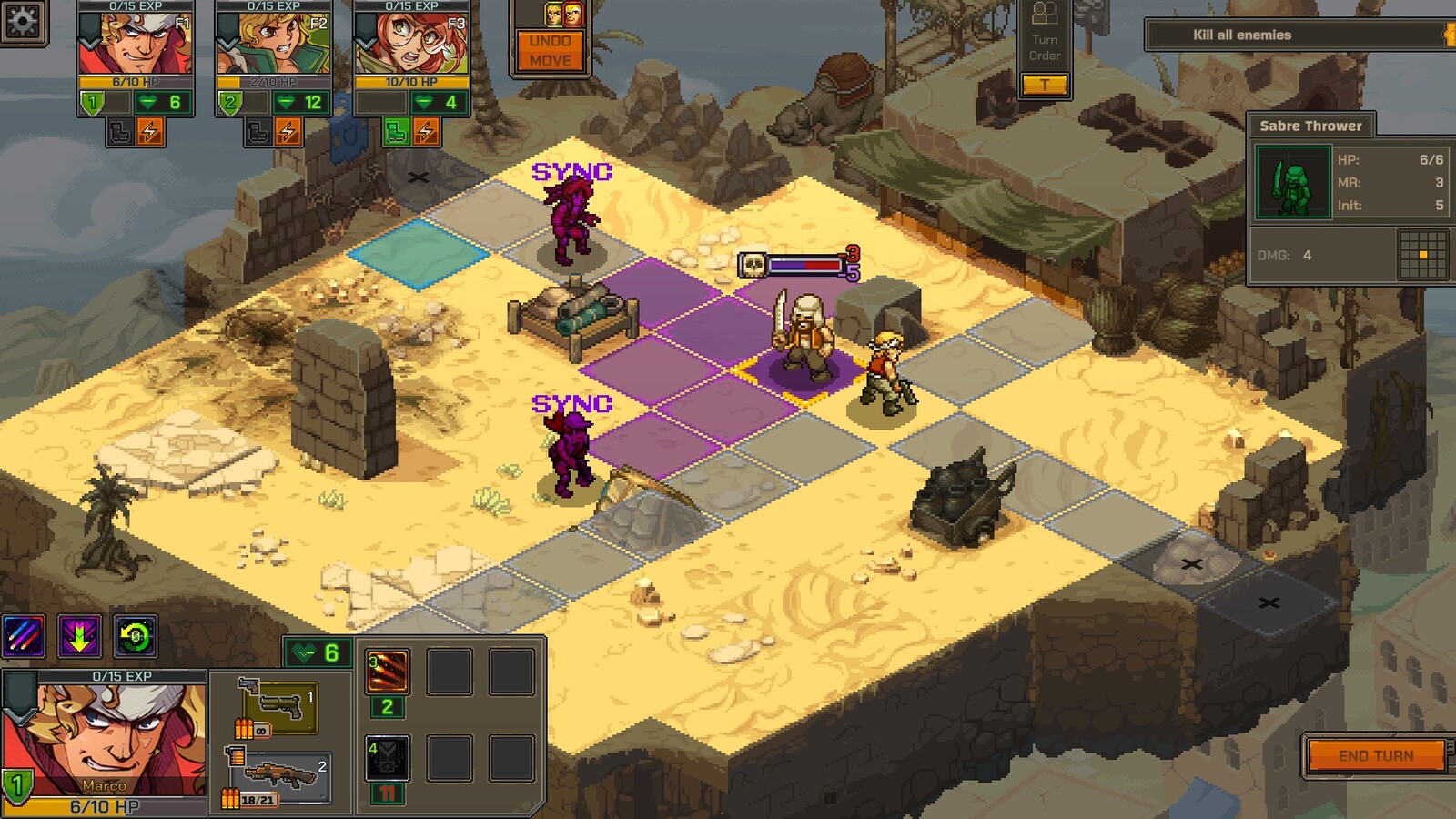
Metal Slug Tactics takes an unusual turn for a series that typically focuses on fierce, arcade-style run and gun action. Metal Slug and other games like it stand out due to their simple appeal. The amazing graphics and easily understood gameplay draw you in, while uncovering their hidden depth keeps you coming back. After playing its recent demo, I felt that Tactics targeted an appeal that feels like it sits in an entirely different direction. It’s a game better suited for kicking back and contemplating deeply on your rocket lawnchair than standing at an arcade cabinet. Luckily, it fires at its target with the Heavy Machine Gun, so some of the Metal Slug appeal ends up getting caught in the crossfire anyway.
Obviously Tactics at least bears resemblance to its predecessors visually. The aesthetics of Metal Slug were crafted by some of the finest artists to ever work in the game industry and Tactics captures its essence faithfully. As far as the spritework goes, not only does everyone and everything look the part, but the overall style translates surprisingly well into an overhead tactical format. I love all of the details in the animations especially – whether it’s watching Marco and the crew’s antics while idling at the home base or enemies reacting to getting blasted, none of the spectacle gets lost in the shuffle from side view to isometric.
What does get lost, however, is the arcade-y pick up and play nature of Metal Slug. Unlike an arcade game, I wasn’t able to just jump into Tactics and start blasting. Given the nature of the genre, that’s understandable to a degree. Still, there are plenty of tactics games where you can get by with just the basics for a while and then be eased into the nuance; this just isn’t one of them. After playing the tutorial, I still had to do a lot of reading about abilities, fiddling with the controls, and even experimenting with different mechanics before I really understood the game.
Tactics owes its learning curve more due to convolution than complexity. I felt like I had to play a few rounds of the game to parse the game on both a visual and mechanical level.
One of the biggest triumphs of Metal Slug’s visual design is that beyond just being impressive, it’s well-suited to the gameplay. You can clearly read what’s going on in the game at a glance. Not so much with Tactics in its current state. The cover system makes sense when you know the rules, but it doesn’t logically follow how it looks on the screen. The terrain will occasionally have gaps for the characters to hop across, but they don’t seem to have any gameplay connotation. Despite the fact that your characters use all manner of ranged firearms, they can’t fire from a rooftop down to enemies below. I often felt like the game was catching me off-guard because so much of what happens on-screen is tied to abstract game logic rather than what makes visual sense.
Similarly, just controlling the game takes some practice. When you try to interact with things around the environment, the game doesn’t convey the power of your clicks. For example, you can activate cranes to drop boxes on nearby enemies. Logically you’d think you would just need to move the character over to the crane and the boxes drop, but clicking on the crane doesn’t provide any real feedback. What you have to do is click the crane and then scroll over to where the crane is to be able to select where the boxes drop yourself. The tutorial tells you this, but it’s easy to forget maps later when it becomes relevant again. There are a few little things like this that, while minor, could use some streamlining. Given that Metal Slug Tactics will be coming to consoles, and thus be played on controllers (the PC demo only lets you use mouse and keyboard), I’d guess that the controls will get another pass before release.
Once you clear the initial hurdles, you can cut your teeth on the real meat of the game: all of the different abilities, stats, and strategies at your disposal. Each character has unique attacks and different perks you can gain from leveling them up. Some are immediately obvious as to why they’re useful, while others left me puzzled. Until you go through multiple runs of the game, it’s difficult to understand the long-term benefits or consequences for what you choose to invest in, as the descriptions are both numerous yet also inefficient at conveying information. Yet another barrier to stop you from getting to the good stuff.
Metal Slug Tactics does eventually click when you give it some time. It may not share much in terms of logistics with its arcade brethren, but it conveys their spirit in interesting ways.
One of the most defining factors of Metal Slug is your vulnerability. While you can easily blast your foes away in a single shot in a typical Metal Slug adventure, they can just as easily return the favor. That element of risk keeps you on your toes and emphasizes the importance of mastering all the nuances of the gameplay. Tactics conveys its own spin on this concept by making your individual soldiers feel rather weak and vulnerable unless you play properly. Placing them behind cover proves essential to keeping them alive. Attacking enemies with a lone recruit will barely scratch them, but by placing your units in proximity to each other you can perform sync attacks to clear the map in a reasonable timeframe.
These gameplay considerations transform the turn-based tactical setup into the closest approximation of a run and gun platformer possible. Going from cover to cover and keeping your squad from getting swarmed makes up the majority of the moment-to-moment gameplay. You constantly need to keep your team on the move while also thinking carefully about every move you make. Many map objectives further encourage this style of play by giving you specific targets scattered throughout the map to defeat, rather than simply forcing you to clear a whole map of enemies. I wouldn’t necessarily describe Tactics as fast-paced, yet it simulates the fast-paced feel of Metal Slug in a creative format.
After clearing the initial learning curve, I had a good time with Metal Slug Tactics. The demo offers just a chunk of the overall game, so I’m excited to see how the tactical gameplay progresses as you gain more units and abilities. Given that there’s still some time before release, I can see the dents on its Metal Slug’s armor being polished as well. Metal Slug may be as far removed from the realm of turn-based strategy as it gets, but Tactics looks primed to successfully complete its mission in making it work.



